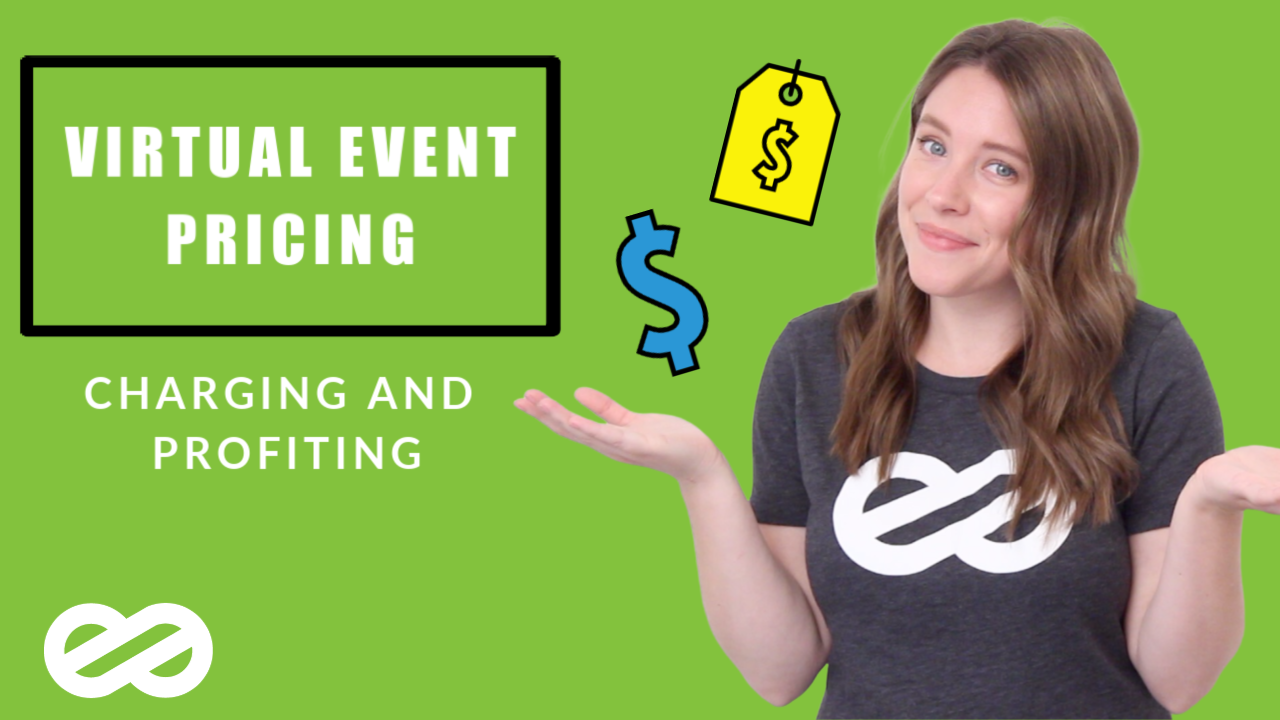
In today’s post, we’re discussing virtual event pricing. So, you decided to take the jump from in-person to virtual. And you hired the best virtual event production company out there to help you put together an amazing experience. But now, it’s time to think about the particulars. One of the hardest things to figure out is the virtual event pricing model. Because this is probably the first time you’re venturing into this world, you don’t really know where to start.
Should you charge the same you would for an in-person event? Should you just make it free, since it’s the first time you’re planning an event like this? What are other sources of revenue you can add? These are only some of the questions that might be popping into your mind when considering virtual event pricing. So we decided to give you a hand! Keep reading and learn how you can go about deciding how much to charge for your virtual event – and how to drive extra revenue to your organization!
The Path To Profit
Much like you would do with an in-person event, you need to calculate how much your ideal price would be in order to turn a profit. This won’t be new ground for you – assuming you’ve planned events before, you know how to go about this simple equation.
Because you don’t have any historical data to draw from (unless you’ve put on a virtual event before) you’ll have to carefully map out all of your costs. This will include things like speaker fees, entertainment fees, event platforms, the technical and production costs, and so on. By knowing exactly what your expenses are you’ll be better equipped to calculate the return on investment of your virtual event.
It’s also important that you keep the goals of your event in mind. What do you expect to accomplish with this experience? Are you looking to increase brand awareness? Increase sales? Generate leads? Only by knowing what the ultimate objective is can you successfully know what the metrics you’ll be measuring are. Measuring the success of your event with accurate data will go a long way in helping you price future virtual events!
Research, Research, Research
Finding inspiration from your competitors isn’t unheard of. But this time around, we have a sneaky tip for you! Instead of checking out virtual event pricing from other events, take a look at online course platforms. There are hundreds of platforms like this that offer courses and packages about everything and anything – sales, marketing, business, pottery, you name it!
A great way to get a benchmark is to see how these online courses are priced. Let’s say you did your research and found that the average price for a five-hour course on crisis communication is $350. If your virtual event will offer ten hours, along with extra perks and state of the art speakers and trainers, you can charge double or more – $700 and above.
This is, of course, a hypothetical example. But it illustrates how you’ll want to go about creating a solid benchmark for your virtual event. It shows you how much an audience who is interested in a particular field is willing to pay to be provided with in-depth courses and seminars on the subject. And chances are, some of your audience fits in that bubble. So put your scientist cap on and get researching places like Udemy to see what’s up!
Consider A Subscription Model
One of the top concerns that come along with planning a virtual event is attendee engagement. Webinar fatigue is a thing and, as we explained before, the chances that you’ll keep your attendees hooked for as long as you would in an in-person event are very slim.
This is where a subscription model can help, both where it comes to pricing and attendee engagement! Subscription models are already popular with consumers everywhere. Why not use this to your advantage and turn your own virtual event into a subscription model based one?
Consider this: why not offer your attendees the chance to access a one-hour session every day for thirty days for $100 a month? This way, you’ll have your audience’s undivided attention since you’re only asking for an hour as opposed to six days back to back, five hours each day.
And this is just for live sessions! The great thing about this kind of model is that it can represent a continuous source of revenue for your company. Aside from offering live sessions, you now have an entire library of content in the likes of Hulu, Netflix, Disney +, and Amazon Prime that has been previously recorded. This means you can offer access to all of this existing content to your target audience. If it’s something along the lines of educational content, they’ll be more than willing to pay for it. Not only will you be bringing in continuous revenue from what could be considered a dormant source, but you’re also promoting future live virtual events.
And let’s not forget the repurposing possibilities that this offers. If you planned virtual events that included five sessions on effective sales tactics, why not put them together and sell them as a bundle? The perks are endless and represent a new world of profit-generating opportunities that wouldn’t be possible with in-person events.
Think About Different Tiers & Features
Who’s to say you have to charge the same to all your attendees? Just because your event is going virtual, it doesn’t mean you can’t offer extra features that will make your event more appealing, thus making people want to pay a higher price to have access to said features.
Above we discussed subscription models. A popular pricing strategy in services like that is to offer extra perks and tiering the prices accordingly. This is something that can easily apply to your virtual event pricing strategy.
Let’s say you’ve decided on a fee of $250 for the standard experience of your event. This will include access to the speaker sessions, breakout rooms, Q&A sessions, etc. But you’re trying to figure out a way to offer your attendees something that will lead them to pay more. So you create a “Premium Tier” that costs $350 and gives exclusive access to materials prepared by the speaker and an entertainment session post-event with a band (think something along the lines of a live stream). Awesome! But you don’t have to stop there. You can add yet another tier, a “VIP” one, that will cost $450 but offers the attendees all of the perks mentioned above plus a one-on-one session with their preferred speaker to get precious insights that weren’t offered during the standard session. You can also throw a virtual goodie bag in there that includes something like a voucher for an online store selling something relevant to your audience.
Again, this is just an example. But if you know your event and your audience well, you’ll be able to create these tiers that offer features your attendees simply can’t pass up on!
Know Your Worth
Because virtual events are such a novel thing that every planner is now jumping into, making the first event free or extremely cheap seems like the best way to ensure people will actually attend. After all, you won’t be able to offer the same experience you would in a “normal” event, right? So why would people bother showing up?
Wrong! The best advice we can give you on this front is don’t do it. Remember that you have worth, and you are providing your attendees with a valuable experience that will enrich their lives in some way. Offering yourself for free or selling yourself short will do you no favors.
Will Curran, CEO of Endless Events, actually believes you should charge the same thing for your virtual event that you would charge for the in-person experience. “You’re bringing something to the table that has value, and people will benefit from that value”, he says. “You should always push for charging, and charging the same you would under regular circumstances. Your attendees aren’t going to an event for the excellent catering – they’re going because of your expertise because they believe their time and money are worth it. So don’t convince yourself that charging less or not charging at all will help you achieve your goals”.
Remember that the way audiences consume content has completely shifted in the past few years. The rise of Netflix, Youtube, and Twitch has revolutionized how audiences perceive live streaming. People will happily pay to get access to top-notch content they can consume through screens. So you can’t be concerned about pricing something as low as possible to get people to show up. You’re doing yourself and your organization a disservice. If you truly believe in your worth, if you know you’re offering something unique and valuable, why wouldn’t you charge based on that? The right people will flock to your event!
Find Additional Revenue Streams
Thinking outside the box will go a long way in coming up with additional revenue streams. We’ve already covered how repurposing your content into a subscription model can present itself as an opportunity to continuously drive revenue to your company. But the digital world offers a lot more possibilities than the good old in-person experience.
For instance, you can consider something like affiliate marketing. Amazon has one of the best affiliate programs out there! Contemplate including links to relevant items sold on the website in your virtual event. For every purchase an attendee makes through that link, you get a referral fee. This is yet another amazing source of passive income!
Digital platforms also include the possibility of ad spaces. You can leverage this to your advantage by selling banner and pop-up ad space to potential sponsors of your virtual event. Sponsorships in the world of virtual events are an amazing source of revenue in themselves – aside from advertising, you can promote them through your speakers, slides, videos, social media channels, sponsored Q&A sessions, and more.
Get your creative juices flowing and you’ll come up with brilliant ideas!












